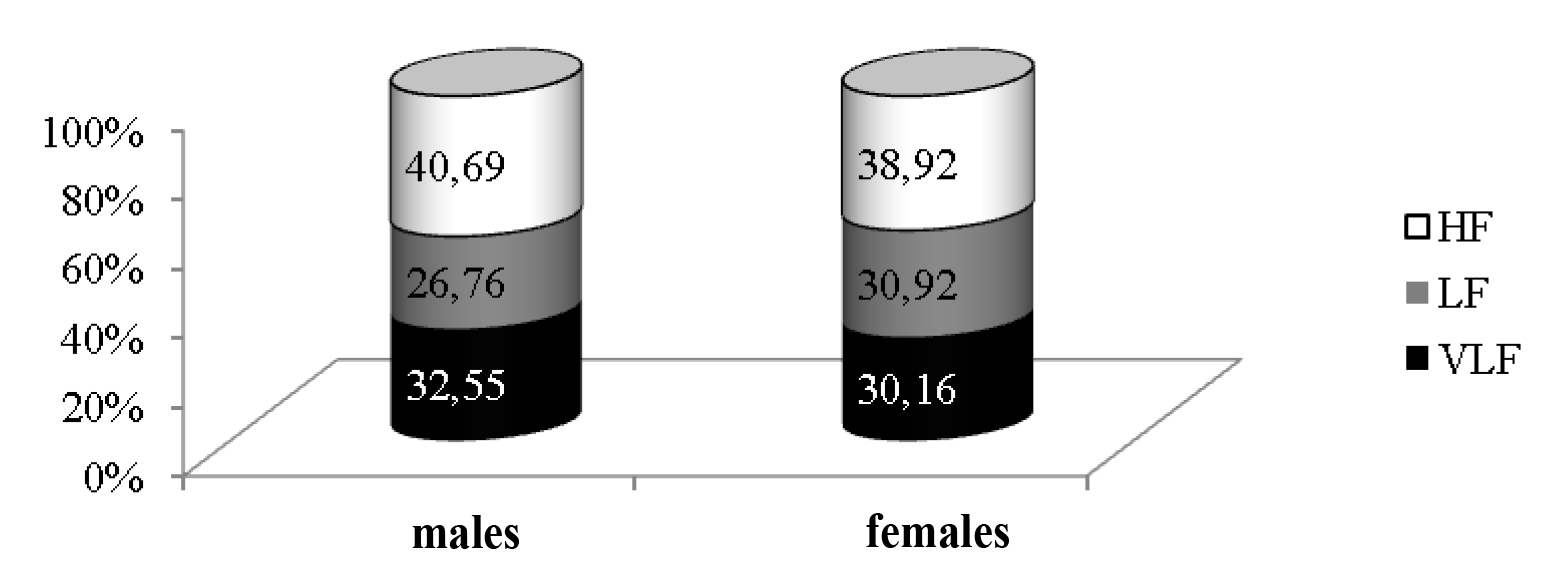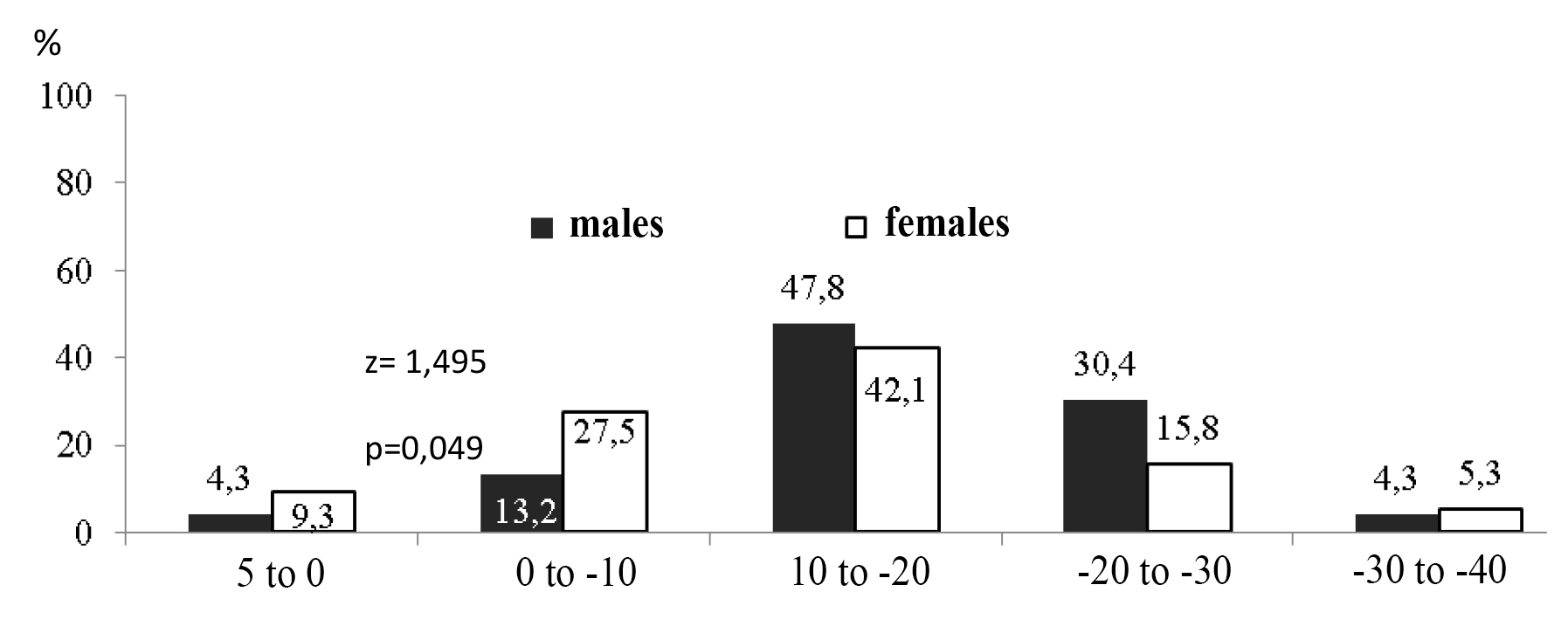Physical education and sports department students residing in Khanty-Mansi Autonomous Region (Yugra); regulatory mechanisms and vascular system condition analysis
Фотографии:
ˑ:
Dr.Biol., Associate Professor A.A. Govorukhina1
Dr.Med., Associate Professor O.A. Malkov1
Dr.Biol., Associate Professor О.L. Nifontova1
A.A. Novoselova1
PhD E.E. Ibragimova2
1Surgut State Pedagogical University, Surgut
2Crimean Engineering and Pedagogical University, Simferopol
Keywords: vessels, autonomic regulation, stress, adaptation.
Introduction. Young students are a cohort with a set of social, economic, emotional and other characteristics. Different functional and mental disturbances may develop in students when learning due to improper organization of their work-rest regime, monotonous learning environment, as well as heavy physical loads common for student-athletes. Early detection and prevention of cardiovascular disorders and abnormalities in the regulatory mechanisms are particularly relevant in the North, where the negative effects of intellectual, emotional and physical loads are imposed on constant stresses caused by biologically uncomfortable natural environment.
Objective of the study was to analyse the condition of the regulatory mechanisms and vascular system in the Physical Education and Sports Department students residing in Khanty-Mansi Autonomous Region - Yugra.
Methods and structure of the study. The research was carried out at Surgut State Pedagogical University at the premises of the scientific research laboratory "Biological Aspects of Safe Learning Environment" in 2017. Subject to the study were 84 physical education and sports department first-year students (46 males and 38 females, mean age 18.29±0.23 years). All the examined students were 1st-2nd-generation migrants, with an average duration of residence in the North of 17.3±0.43 years. The parameters characterizing the vascular system condition were registered for 2 minutes using the AngioScan-01P device. The parameters were as follows: biological blood vessels age, arterial stiffness, stress level, heart rate, saturation index (hemoglobin oxygen saturation). Cardiorhythmography was recorded and analyzed using the hardware-software complex Poly-Spectrum-8. We analyzed the results of the temporal and spectral analysis of HRV, calculated the indices of centralization (IC) and activation of the subcortical centers (IASC): IC = (LF+VLF) /HF, c.u., IASC = LF/VLF, c.u. The psychological state of the examined students was determined by evaluating the level of trait anxiety (Spielberger state-trait anxiety inventory) and depression (W. Beck depression inventory). The statistical data processing and systematization of the materials were made using the Statistica 8.0 software; the correlation analysis was carried out by the Spearman’s rank correlation coefficient.
Results and discussion. Highly frequent stresses, typical for students leading a dynamic way of life, as well as common anxiety and depression can be accompanied by cardiac arrhythmia. 8% of first-year males and 5% of first-year females were diagnosed with mild depression; 17% of males and 21% of females had an increased level of trait anxiety, while 30% of the examined males - low level. Such individuals do not take proper care even in the hour of real danger, precaution is unlike them, their level of self-control is lowered.
Maintenance of the optimal level of autonomic functions is the most important indicator of successful adaptation [1]. Heart rate is the most labile indicator, by the changes of which we can be judge not only of the state of the cardiovascular system, but of the whole body as well. The analysis of the ratio of waves, forming the general spectrum of heart rate variability of the examined students, revealed that the greatest contribution to the spectrum structure is made by the HF-component, which reflects the spectrum power within the high-frequency range and characterizes vagal control over heart rate. The predominance of the high-frequency component testifies to the intensive parasympathetic activity of the autonomic nervous system among students residing in KhMAR-Yugra (Fig. 1).

Fig.1. Spectral structure of students’ heart rate variability
It was found that, most commonly, the examined students were characterized by pronounced parasympathicotonia (LF/HF<1.5), which indicates a decline in the central influence on the autonomous contour of regulation; autonomic balance (LF/HF ranging from 1.5 to 2.0) was registered in only 13% of males; 10% of females were diagnosed with sympathicotonia. It was also found that the stiffness index in the females (75.7 c.u.) significantly exceeded that in the males (45.03 c.u.), which testifies to a more detrimental sympathetic effect. In terms of the index of activation, the females surpassed males insignificantly (1.51 versus 1.38 c.u.), while in terms of the index of centralization, they surpassed males significantly (5.89 versus 2.35 c.u.). The increased aortic augmentation index (AIp), as an indicator of arterial stiffness, is associated with an increased cardiovascular risk [1, 7, 8].
Assessment of the arterial stiffness can be used for screening purposes in off-clinical diagnoses of atherosclerosis and high cardiovascular risk groups [3, 5, 6], it allows to evaluate the ability of the arterial wall to stretch under the influence of the blood flow [4]. The results of the analysis of the blood vessels stiffness AIp in the examined students are illustrated in Figure 2. The distribution of students by the augmentation index showed that in 5.3% of females the age norm was above average, and that the degree of blood vessels stiffness in females was higher than in males. But at the same time, males were found to have higher stiffness index (SI), which in 17.4% of cases exceeded the norm (Table 1).

Fig. 2. Distribution of students by degree of blood vessel stiffness, %
An increase in the arterial stiffness can come out of a combination of a number of interrelated age-specific and pathological disorders and can lead to serious negative hemodynamic consequences. It is the increase in the blood vessels stiffness that is considered to be the principal sign of their aging and is associated with calcium build-up in the vessel walls, increasing amount of collagen and reduction of elastin, development of endothelial dysfunction [2].
Table 1. Parameters characterizing students’ vascular system condition, М±m
|
Parameter |
Males |
Females |
|
SI |
7.51±0.12 |
6.84±0.06*** |
|
AIp 75 |
-16.87±1.34 |
-14.71±1.23 |
|
AIp |
-18.78±1.72 |
-13.87±2.73 |
|
AGI |
-0.89±0.03 |
-0.88±0.02*** |
|
SPa |
116.13±1.52 |
107.37±1.37*** |
|
RI |
21.64±1.32 |
23.5±1.2 |
Note: Alp – augmentation index, Alp75 – augmentation index normalized to heart rate of 75 bpm, SI – stiffness index, RI – reflection index, SPa – central systolic pressure, AGI – age index.
It is estimation of the blood vessels age that makes it possible to assess the condition of the small arteries, which are meant to ensure the optimum delivery of blood to the tissues [7]. It was established that the blood vessels age did not correspond to the formal one in either of the subjects (Figure 3). It was older by their actual age by 1 to 40 years. At the same time, a more pronounced discrepancy between the formal and blood vessels age was found in females.

Fig. 3. "Blood vessels age" exceeding formal age of examined students, %
More pronounced deteriorations in the condition of the small vessels in the males were also confirmed by the age index (AGI) values (Table 1). The research findings also indicate an unsatisfactory condition of the small arteries, which may be due to the vascular endothelium dysfunction and increased risk of atherosclerosis. Estimation of the blood vessels age, as a derivative of the age index, is one of the most significant indicators for the cardiovascular risk prediction [7].
More than 20% of the females and 13% of the males were characterized by the high values of the reflection index (RI), which indicates a high tone of the small muscular arteries (Table 1). At the same time, the central systolic pressure in the males was higher than that in the females. We found stresses in 21% of the examined females and 8% of males, with 4.4% of the males diagnosed with significant stresses. It can be assumed that a relatively high stress level is determined by a set of environmental factors [3], since the study was conducted during a stable period of training and the students performed their usual intellectual and physical loads.
Conclusion. The study found the average level of trait anxiety in the majority of the examined students and high level in 17% of males and 21% of females; the frequency of depression amounted to 8.7% of males and 5.3% of females.
Heart rate regulation of first-year students living in KhMAR-Yugra is characterized by the great influence of the parasympathetic division of the autonomic nervous system. There are significant gender-specific differences between the vascular system condition indicators. Herewith, more pronounced irregularities in the large and small blood vessels stiffness in males are not compensated by a decrease in the tone of the small peripheral arteries, which causes higher central and peripheral systolic pressure. We found stresses in 21% of the examined females and 8% of the males, with 4.4% of the males diagnosed with significant stresses.
References
- Vasyuk Y.A. Soglasovannoe mnenie rossiyskikh ekspertov po otsenke arterialnoy zhestkosti v klinicheskoy praktike [Coordinated opinion of Russian experts on assessment of arterial stiffness in clinical practice]. Kardiovaskulyarnaya terapiya i profilaktika, 2016, no. 2, pp. 4-19.
- Gapon L.I., Shurkevich N.P., Vetoshkin A.S. Arterialnaya gipertenziya v usloviyakh Tyumenskogo Severa. Desinkhronoz i giperreaktivnost kak faktory formirovaniya bolezni [Arterial hypertension in conditions of Tyumen North. Desynchronosis and hyperreactivity as factors of disease formation]. Moscow: Meditsinskaya kniga publ., 2009, 208 pp.
- Mishina E.A. Sistemny analiz sezonnoy i sutochnoy ritmiki parametrov funktsionalnykh sistem organizma, prozhivayushchikh na Severe RF. Avtoref. dis. kand. biol. nauk [System analysis of seasonal and diurnal rhythms of parameters of body's functional systems of Northern residents of the Russian Federation. PhD diss. abstract]. Tula, 2007, 24 pp.
- Morozov V.N., Khadartsev A.A. K sovremennoy traktovke mekhanizmov stressa [Modern interpretation of stress mechanisms]. Vestnik novykh meditsinskikh tekhnologiy, 2013, vol. ХVII, no. 1, P. 15.
- Denham J. et.all. Aortic augmentation index in endurance athletes: a role for cardiorespiratory fitness. Eur J Appl Physiol., 2016, vol. 116, no. 8, pp. 1537-1544.
- Prodel E. et.all. Relationship between aortic augmentation index and blood pressure during metaboreflex activation in healthy young men. Blood Press Monit., 2016, vol. 21, no. 5, pp. 288-294.
- Townsend R.R. Arterial Stiffness: Recommendations and Standardization. Pulse (Basel)., 2017, vol. 4, no. 1, pp. 3-7.
- Trudeau L. Central blood pressure as an index of antihypertensive control: determinants and potential value. Can J Cardiol., 2014, vol. 30, no. 5, pp. 23-28.
Corresponding author: physical_science@surgpu.ru
Abstract
The study was designed to analyse the vascular system condition, autonomic nervous system regulation and mental conditions of the Physical Education and Sports Department students residing in the Russian Northern Khanty-Mansi Autonomous Region (Yugra). The study data demonstrated a high contribution of the parasympathetic division of the nervous system to the heart rhythm control, with contributions of different components to the heart rhythm autonomic regulation spectrum being rated. We found domination of the HF-component characteristic of the spectrum scale in the high-frequency range and vagal control of the heart rhythm; calculated the centralisation, subcortical centres activation and tension indices; found statistically significant gender-specific differences in the tension indices; determined the blood vessels stiffness and age rates; identified the students whose blood vessels age is notably older than the formal age; demonstrated that the female subjects’ blood vessels stiffness was higher than that of the male subjects; found gender differences in the personal anxiety, depression, stress and the key control mechanisms performance rates; and found stresses in 21% of the female and 8% of the male subjects, with 4.4% of the males diagnosed with significant stresses. The study data may be applied for screening purposes in off-clinical diagnoses of atherosclerosis and high cardiovascular risk groups.


